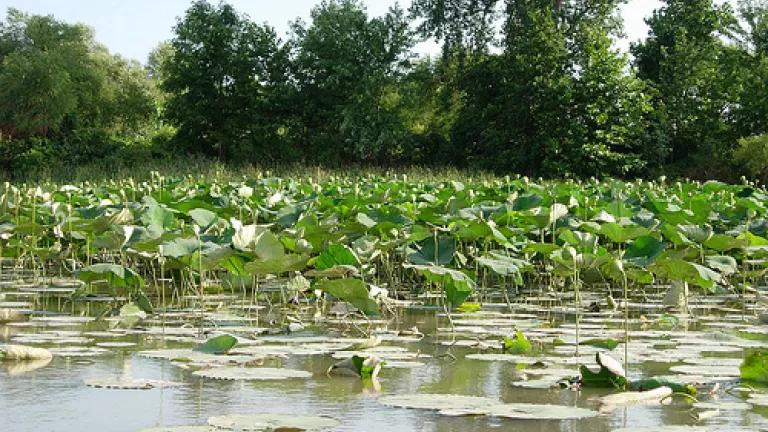
The majesty and magnitude of the Great Lakes themselves can distract us from the smaller, but equally critical, rivers, streams, wetlands and other water bodies that feed Lakes Huron, Ontario, Michigan, Erie and Superior. Nearly two-thirds of the Great Lakes Watershed is made up of these tributary waters, meaning that as a whole they are larger than the open waters of the Lakes themselves.
These smaller water bodies are essential for the health and continued vitality of the Great Lakes. They remove contaminates from water, manage floods by absorbing storm water, provide habitat for multiple plants and animals, and act as natural reservoirs that reduce the impact of droughts by storing ground water and recharging aquifers. To overlook, and fail to protect, these water bodies, disrupts the water cycle our clean water depends upon. It harms the essential components of our fresh water system, and ultimately consigns the Great Lakes to dangerous decline. This is the course we have followed, especially over the past decade, imperiling the fresh water at the center of our communities, economy and culture.
For more than a decade, thousands of those smaller waterbodies have been at greater risk of pollution and destruction because of two Supreme Court decisions, and subsequent actions of bureaucrats in the Bush Administration. These decisions put in question whether a wide range of waterbodies were under the protection of the Clean Water Act. Falling into legal ambiguity, these waterbodies suffered neglect, pollution and even destruction.
Consider, for instance, wetlands. They provide multiple services: storing water, recharging ground water, moderating floods and providing critical habitat for plants, amphibians and birds, many of them endangered. Here in the Great Lakes region, in the 19th and early 20th Centuries, we lost the majority of wetlands, with their destruction continuing until the Clean Water Act came into effect in 1972, providing needed protection.
But after the Supreme Court rulings that cast doubt over the effective of the Clean Water Act, an estimated 90 percent of the wetlands remaining in our region have been at increased risk due to uncertainty over whether they are subject to Clean Water Act safeguards.
This dangerous situation is about to change, as the result of action by EPA and the Army Corps of Engineers: they issued, yesterday, on May 27, a new rule that goes a long way towards ending that uncertainty. The Clean Water Rule will make it a lot easier to protect many of the streams and wetlands that contribute in whole or part to the drinking water of 1 in 3 Americans. In the Great Lakes region, about 30 million people get their drinking water from these sources.
There are also the small streams and tributaries that provide critical fish and wildlife habitat, making outdoor recreation a significant economic driver of our region, to the tune of $28.3 billion/year. No one likes swimming in dirty water, especially humans. Neither do critters like salmon and trout.
These waters also protect our communities from serious contamination of our drinking water. Consider again the role of wetlands in protecting our water. They are called "nature's sponges" because they literally trap excess rain and runoff, slowly releasing that water over time. This function helps manage floods, as noted above. It also provides protection against dangerous contamination of water, in acting as a sink for nutrients like phosphorous and nitrogen. This function limits the amount of contaminants that are carried into the Great Lakes, where they can feed poisonous algae. Last year's drinking water ban in Toledo, which was caused by poisonous algae produced by nutrient pollution, remains a stark reminder of the importance of small streams and wetlands.
The Clean Water Rule will also safeguard the investment Great Lakes' communities have made in restoring thousands of acres of wetlands and stream miles. EPA estimates that more than 100,000 acres of wetland, coastal, upland and island habitat have been protected, restored or enhanced through federal funding from the Great Lakes Restoration Initiative alone.
No wonder residents in the Great Lakes and across the country strongly support the Clean Water Rule. More than 1 million comments were received during a public comment process that was extended twice last year; 87 percent of those comments supported the rule. In the eight Great Lakes states, more than 240,000 small business owners, sportsmen, religious leaders, public health professionals and environmentalists weighed in with their support.
None of this public support should be surprising -- in poll after poll, Americans express their concerns about water pollution and their support for the Clean Water Rule. While our politicians may have forgotten their 4th grade science lessons on how all water flows downstream, across the Great Lakes we have not - we understand that we can't protect Lake Erie or Lake Michigan if we don't protect the waters that feed them. And, we understand that short-sighted policies that don't fully protect these waters imperils our way of life. As citizens of a great country, we think that we actually have a right to clean water, and that respect for our water resources is part of respect that is due to citizens of a free nation.
It's sort of like being an American.
"Great Lakes Wetland" image by NOAA via Flickr Creative Commons.
